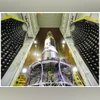Isro on Sunday launched its proven PSLV rocket carrying seven Singaporean satellites from Satish Dhawan Space Centre here.
This Isro mission, which comes after the much-awaited Chandrayaan-3 launch earlier this month, is being undertaken by its commercial arm NewSpace India Limited.
In today's dedicated commercial mission, the primary payload being carried by Isro 's trusted workhorse Polar Satellite Launch Vehicle is the DS-SAR Radar Imaging Earth Observation satellite, which has been developed under a partnership between DSTA (representing the Government of Singapore) and ST Engineering, Singapore.
The 360-kg satellite, upon deployment at an altitude of 535 km into a Near-equatorial Orbit (NEO), would be used to support the satellite imagery requirements of various agencies within the Government of Singapore.
ST Engineering would use the satellite for multi-modal and higher responsiveness imagery and geospatial services for their commercial customers.
The satellite carries a Synthetic Aperture Radar (SAR) payload developed by Israel Aerospace Industries. The payload allows DS-SAR to provide for all-weather day-and-night coverage and it is capable of imaging at 1-metre resolution.
More From This Section
After the 25 hour countdown that commenced on Saturday concluded, the 44.4 metre tall rocket lifted off majestically from the first launch pad at this spaceport, at the prefixed time of 6.31 am, emanating thick fumes on its tail.
Sriharikota is located about 135 km from Chennai on the eastern coast.
Around 21 minutes after lift-off, the primary satellite is expected to get separated from the launch vehicle and the rocket later would deploy the six co-passenger satellites into a Low Earth Orbit sequentially.
The entire satellite separation is expected to take place in about 25 minutes after lift-off, Isro said.
The co-passenger satellites are 1. VELOX-AM,a 23 kg technology demonstration microsatellite, 2. ARCADE Atmospheric Coupling and Dynamics Explorer (ARCADE), an experimental satellite, 3. SCOOB-II, a 3U nanosatellite flying a technology demonstrator payload, 4. NULloN by NuSpace, an advanced 3U nanosatellite enabling seamless Internet of Things connectivity in both urban and remote locations, 5. Galassia-2, a 3U nanosatellite that would be orbiting at low earth orbit and 6. ORB-12 STRIDER, a satellite developed under an international collaboration, the Bengaluru-headquartered space agency said.
Today's mission is the 58th flight of PSLV and using the 17th vehicle with Core Alone Configuration.
According to the space agency, a Core Alone version of the rocket means the vehicle would not use solid strap-on motors on its sides in the first stage as compared to other variants like PSLV-XL, QL, and DL which use six, four or two boosters, respectively.
PSLV has earned its title 'as the workhorse of Isro ' through consistently delivering various satellites into low earth orbits, Isro said.
)